Mercedes-Benz eSprinter electric van review (2024)
The 2024 update removes most of the barriers to buying an eSprinter, but adds some new ones
PROS
- New battery brings huge electric range
- Smooth and comfortable to drive
- Feels sturdy and secure on the road
- Electric hardware well integrated
- Smart infotainment and interior
CONS
- Big battery version can't be driven on normal licence
- Large size might inhibit town use
- Expensive to buy
- Payload not huge for a large van
- Only one length and height for now
Summary
The 2024 version of the Mercedes-Benz eSprinter is far removed from the model that first emerged back in 2020.
When it first came out there was plenty in its favour in some areas, but it was hampered by a short range of just 96 miles – something that was far short of the best electric vans. This has been comprehensively addressed with the 2024 update.
Thanks to the addition of a monster 113kWh battery it now boasts an official maximum range of 271 miles – something that takes the Sprinter to the top of its class in an area where it was previously poor.
As well as this huge new battery, UK buyers will also be able to pick between a choice of two motors for the first time, with a 136hp and a 204hp model available. Other updates include a revamped MBUX infotainment setup and a new brake regeneration system with an ‘auto’ mode.
Lots of familiar features remain
The big changes for the 2024 update are mainly related to that huge battery and the physical attributes of the Sprinter are largely unchanged. The basic appearance is much the same, so it is hardly a drastic facelift in the usual sense of the word.

The versions on offer are all consistent, too, with Mercedes keeping it simple for this big electric van. This means you can only get an L3 version in a single height. There is a large amount of room in the back as a result, with 14 cubic metres of space altogether.
It’s worth bearing in mind that the sheer size of this vehicle might make it a more intimidating prospect for the urban deliveries that electric vans otherwise excel at.
Big battery equals big compromise
There is a notable downside to this, as this large van with a huge battery weighs a large amount. To avoid offering a pitiful payload, Mercedes has classified all 113kWh versions of the eSprinter as having a 4.25-tonne gross vehicle weight.
This means that you won’t be able to simply jump into it if you passed your test after 1 January 1997 and have a standard licence.
Before you run off and start speccing up your new Ford E-Transit, though, there is hope on the horizon in the form of a slightly smaller battery – an 81kWh version will join the range later this year and this will come as a 3.5-tonne model.
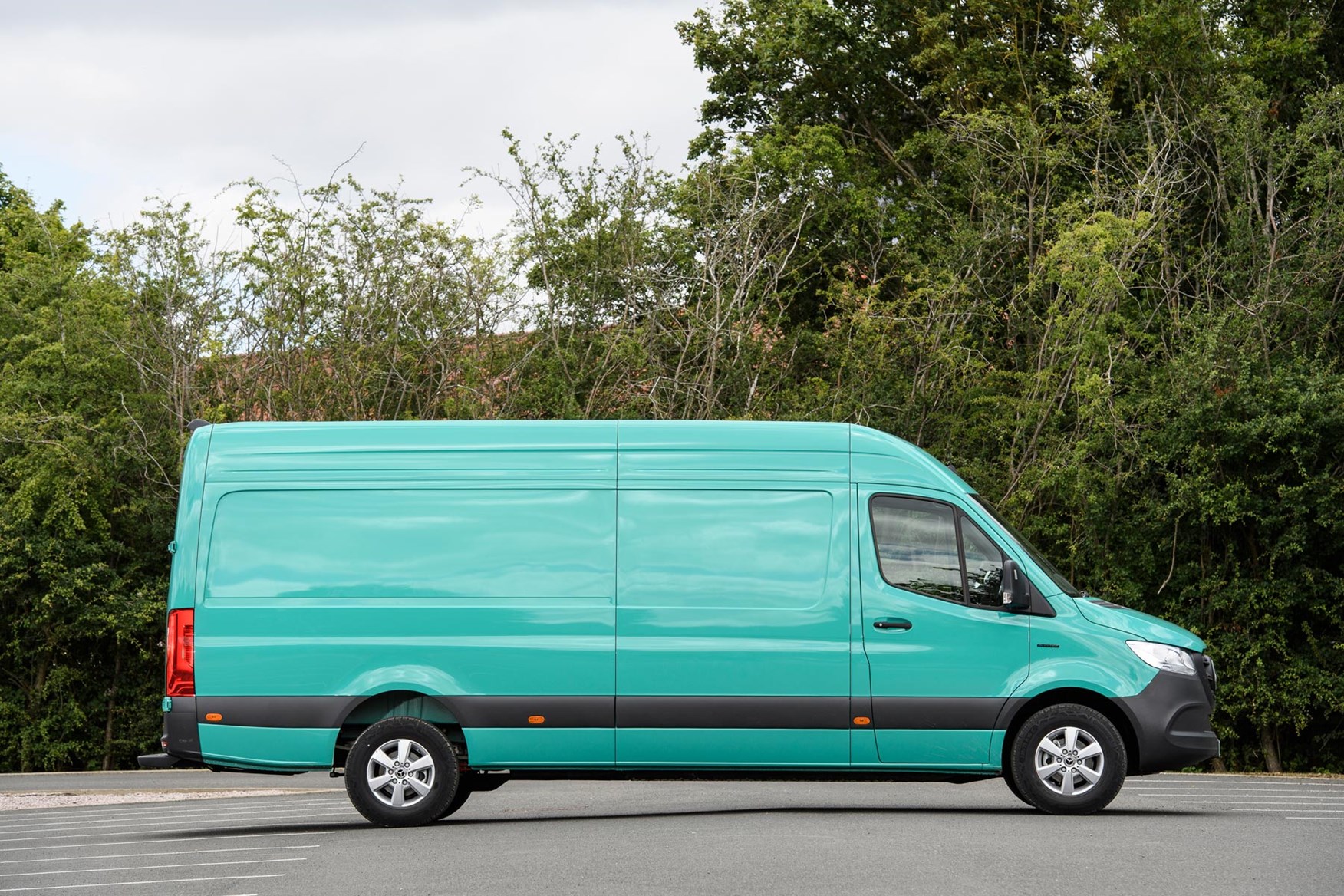
Despite these huge batteries, you should still be able to recharge your eSprinter rapidly. The 113kWh battery will take up to 115kW charging, which means it should be able to get from 10-80% in 42 minutes if you find somewhere that will service it.
If you are limited to AC charging then it will take a little longer – 11 hours on an 11kW wallbox and around 17 hours on a 7kW socket.
What are the Mercedes-Benz eSprinter's rivals?
The large electric van class hasn’t had as many all-new models as the small and medium sectors, but it is slowly getting its act together.
The Ford E-Transit is king among its peers, with a smooth and seamless marriage between the electric powertrain and the UK’s best-selling large van. The Stellantis models – the Citroen e-Relay, Peugeot e-Boxer, Fiat E-Ducato and Vauxhall Movano Electric are all upping their game in 2024 with updates to their batteries that will make them the next best when it comes to range – they will be able to offer up to 261 miles, which is beaten only by the eSprinter.
The all-new Renault Master is on the way in 2024, too, and it promises to be a huge improvement over the aged outgoing model. It too is offering a much-increased range, with 255 miles the promise.
There are others out there too, with the Iveco eDaily also being updated for 2024. Before you get too excited about its 148kWh battery, that is only available on the 7.2-tonne version. The Maxus eDeliver 9 is a strong contender too.
Verdict: is the Mercedes-Benz eSprinter any good?
There are still caveats when it comes to recommending the Mercedes eSprinter, it is just that they are different ones to before. The huge 113kWh battery and 271-mile range have blown away all concerns about how far it will go between charges, but it isn’t as simple as that.
Unless everyone that is driving the eSprinter took their test before 1997 then you will need to factor in their licence status because of the 4.25t gross vehicle weight. If you run trucks as well as vans and your drivers have heavy-good licences then you are fine, but a standard category B licence won’t cut it.
You might be able to get extra training rather than having to upgrade the full licence, but it isn’t as easy as just jumping in and pressing the start button.
There is also the factor of cost. Big batteries come with a large price tag and the sort of public chargers that will give you the 115kW speeds don’t come cheap. But if you can make the financial numbers work, then the most recent updates remove plenty of the barriers that were there before.
Skip to our full verdict on...
- Smooth and comfortable to drive
- Front-wheel drive only
- Large dimensions could prove a challenge in town
Driving the Mercedes eSprinter is a remarkably easy affair in many ways. It’s a keyless start system, so you hop in, press the button and move the steering-wheel-mounted shifter to D and get going.
You could simply leave it at that, but there are a few settings you could tweak with, and these are pretty much all geared towards improving efficiency.
Three driving modes to help maximise range
There is a choice of three driving modes, which are now called Comfort, Eco and Maximum Range. Comfort is the default and leaves everything untouched with the full array of functions and maximum power available.
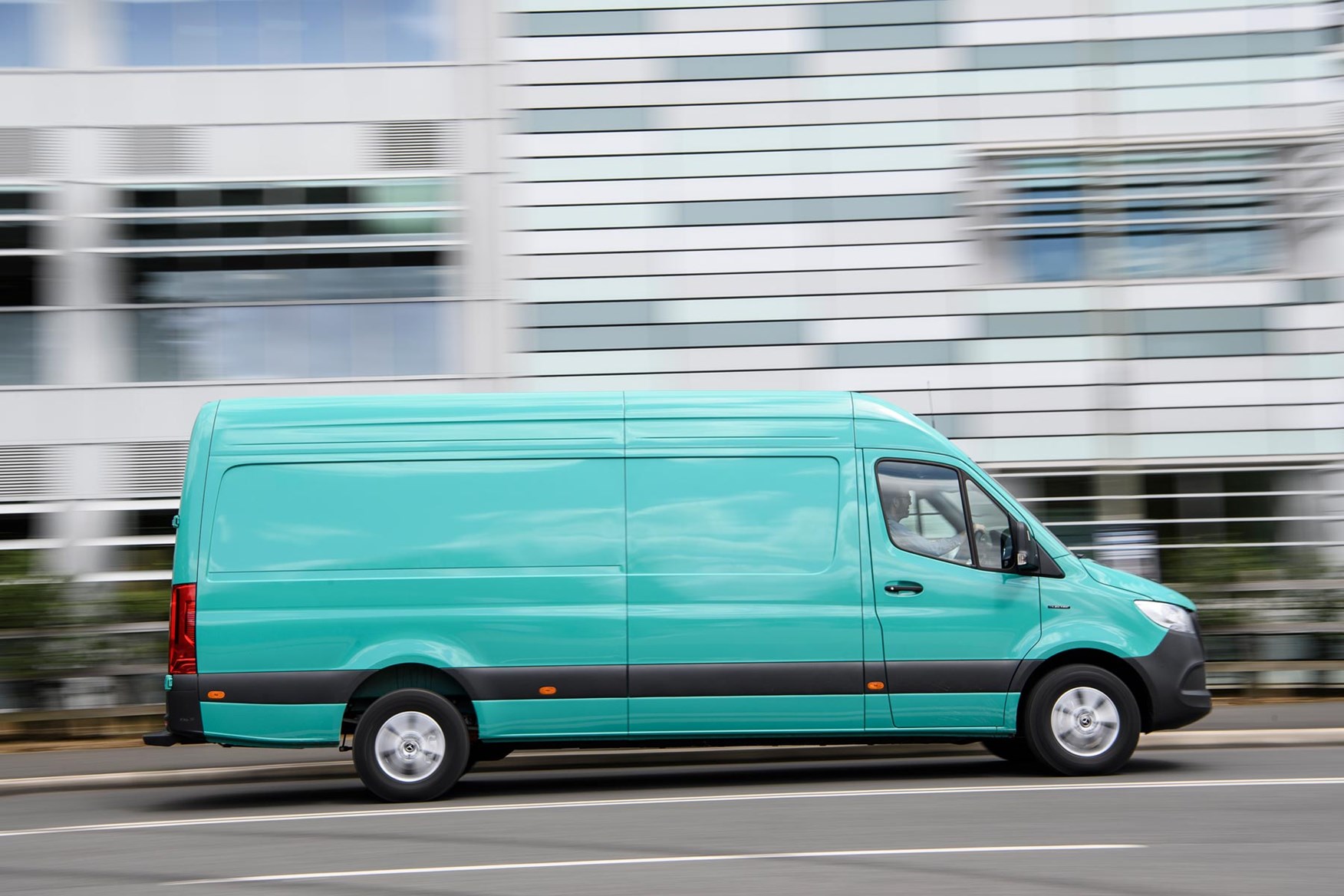
Eco dials back the power on offer, while Maximum Range does so to a greater degree while also limiting some of the other features such as the climate control.
There is a noticeable difference between the different modes when it comes to power delivery but it isn’t a drastic step change so you shouldn’t feel too compromised. These are the same modes as before, but with a different name for the most miserly – it was E+ previously. These modes are all adjusted by a little button that sits just underneath the start button – it’s tucked away to the extent that you might miss it, so it is worth looking for.
You can also adjust the level of regenerative braking via the steering-wheel-mounted paddles. These range from D- to D, D+ and D++, with each one reducing the amount of brake regeneration that you get when you lift off the accelerator. In D- you can do a fair amount of driving on one pedal alone but it won’t take you to a complete halt, even if you are only crawling in traffic.
At the other end of the spectrum in D++ the regenerative braking is totally turned off, so the eSprinter will coast if you lift off the accelerator.
If you don’t want to use these then there is a new mode, called D Auto. The theory is that this will automatically increase or decrease the amount of brake regeneration by using various outside signals. It reads the road ahead and detects slower moving traffic and increases the brake regen if you need to slow down, while it will also take inputs from the navigation and increase or decrease if you are going up or downhill.
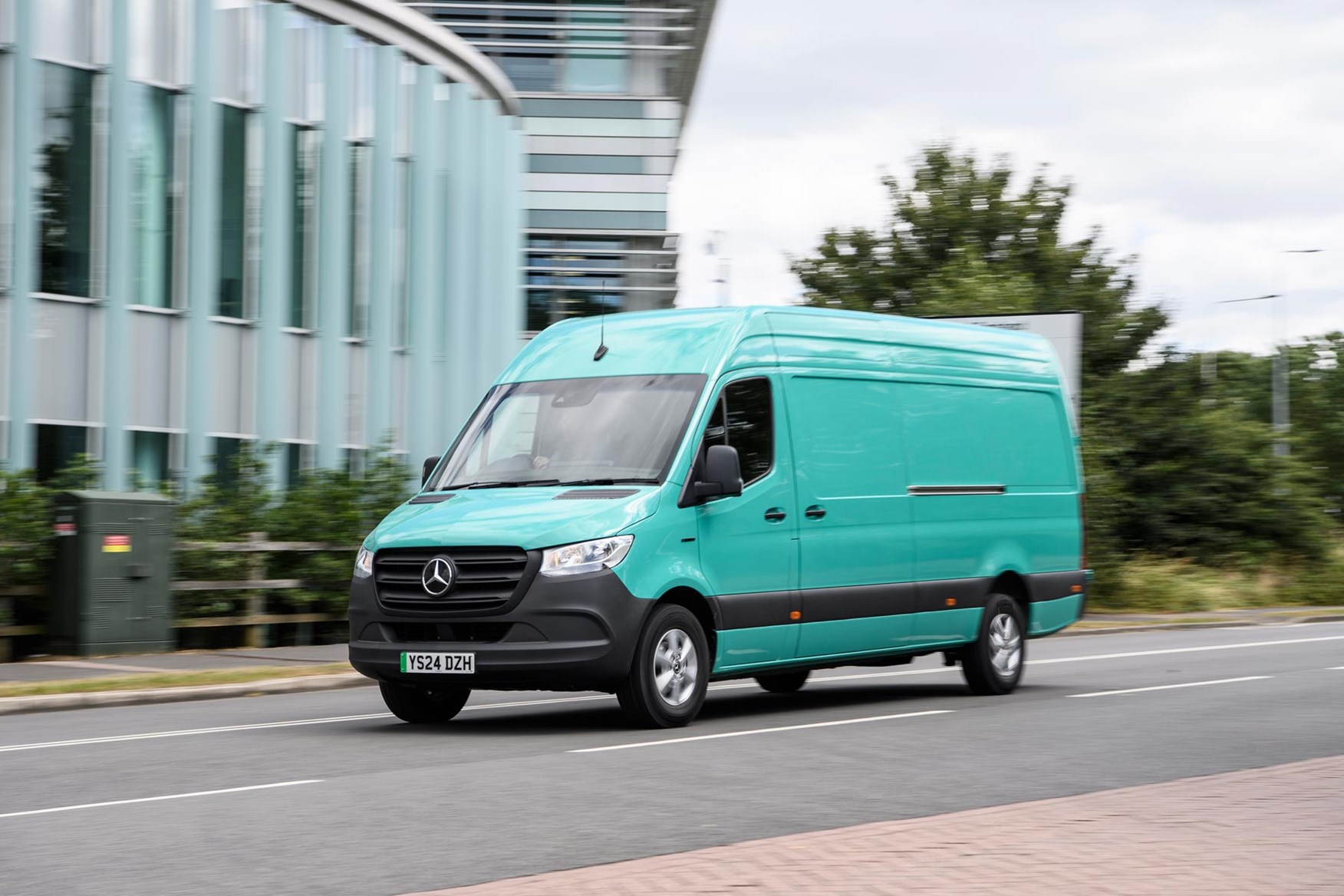
It might not be to your taste, though – it wasn’t to ours – as it doesn’t pick up on stationary cars for example, and never seems to be in quite the right setting. It’s not overly aggressive, though, as it doesn’t go any further in its regen application as D-.
Easy handling with electric power steering
The eSprinter uses the same electrically-assisted steering as the diesel model, which is light enough to make the van super-nimble through town – just where you want it. On faster roads, it weights up nicely, and though there’s little to no feedback it’s a precise and easy-to-manoeuvre van.
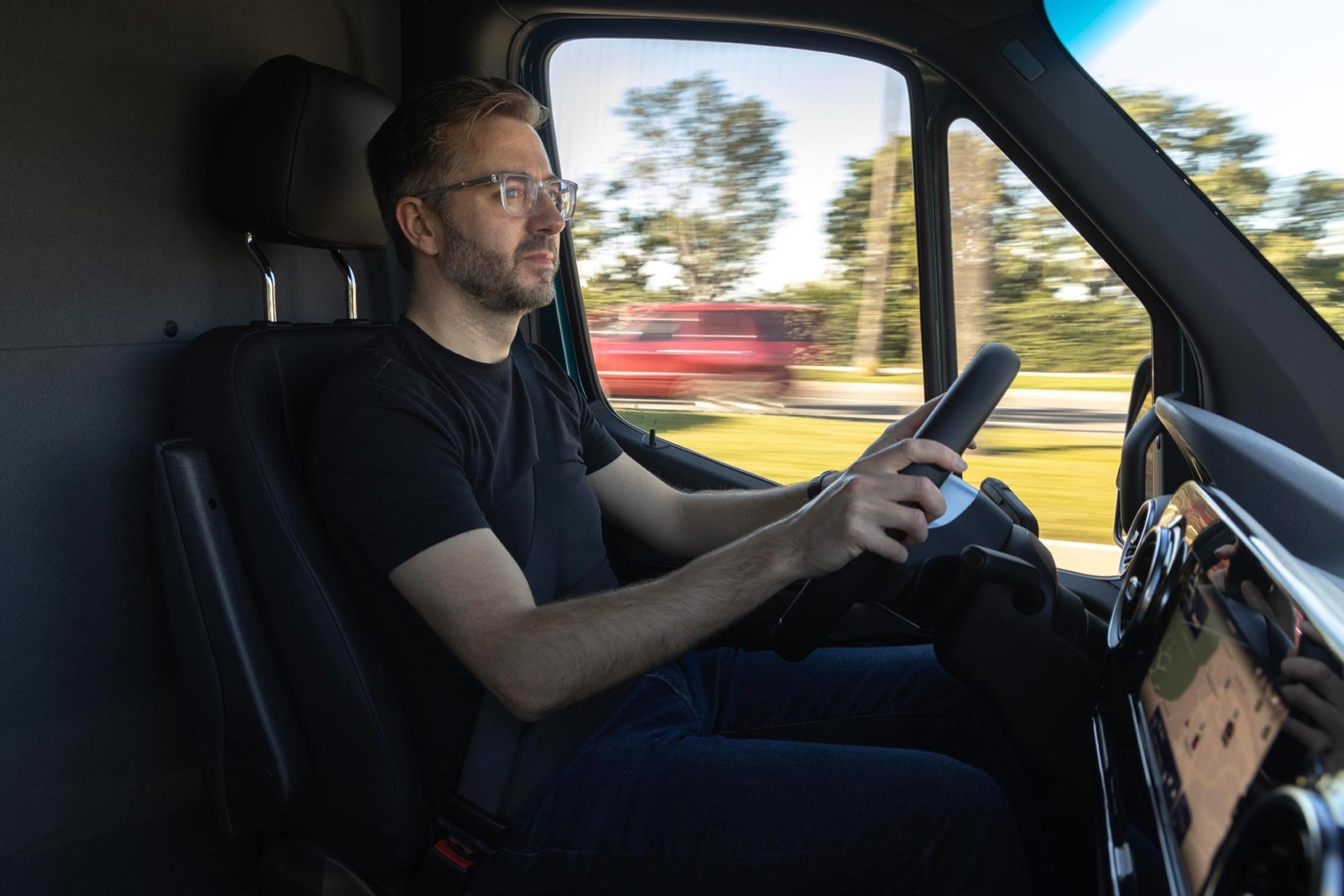
Using electric power steering rather than hydraulic also means the eSprinter has access to safety equipment such as active lane-keeping assist and crosswind assist.
This easy handling and the assured ride quality remain even in this large van that is heavier than most.
- Attractive technology available as standard
- Plenty of storage
- Lots of room and great visibility
The cabin is another area that has improved drastically since the eSprinter first launched. Where it was once a drab and plastic-dominated affair, it is now smart and features a sophisticated touchscreen layout.
This 10.25-inch screen features the latest Mercedes MBUX operating system, wireless connectivity for Apple Carplay and Android Auto and over-the-air updates. It also somewhat dominates the dash, but in a good way as it makes the whole area look somewhat un-van-like.
This extends to the steering wheel, which features several controls at your fingertips – the cruise control. Volume and the settings for the information screen in front of the wheel. The dials there are physical, but you can tweak the display in the middle.
Comfort is top notch
Comfort and visibility levels are above the norm, with seats that offer plenty of adjustment and a driving position that should suit most people. The seats are also designed to be easy to get into and out of, ideal for multi-drop couriers.
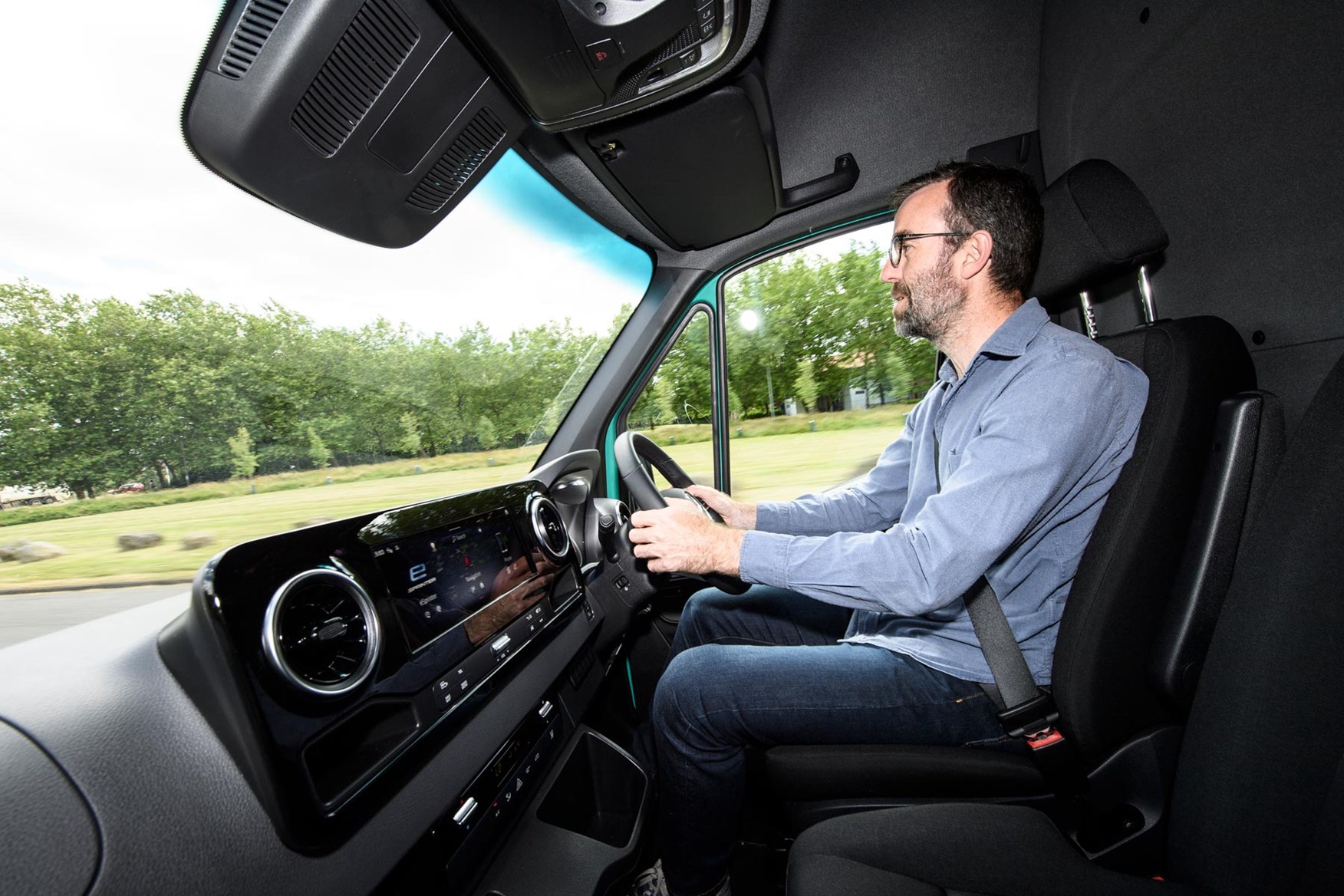
The dashboard doesn’t jut out too much, so there is plenty of room for middle passengers if there is seating for three. Without a middle seat there is loads of space between the two front seats for storage or even for walking through to the rear of the van if you have a bulkhead door.
Loads of big-van storage
Storage is good – there are large door bins and a useful slot above the dash for phones that contains the charging sockets, while small items are taken care of with a trio of deep wells in the dashboard. There’s also plenty of under-seat storage for larger items.
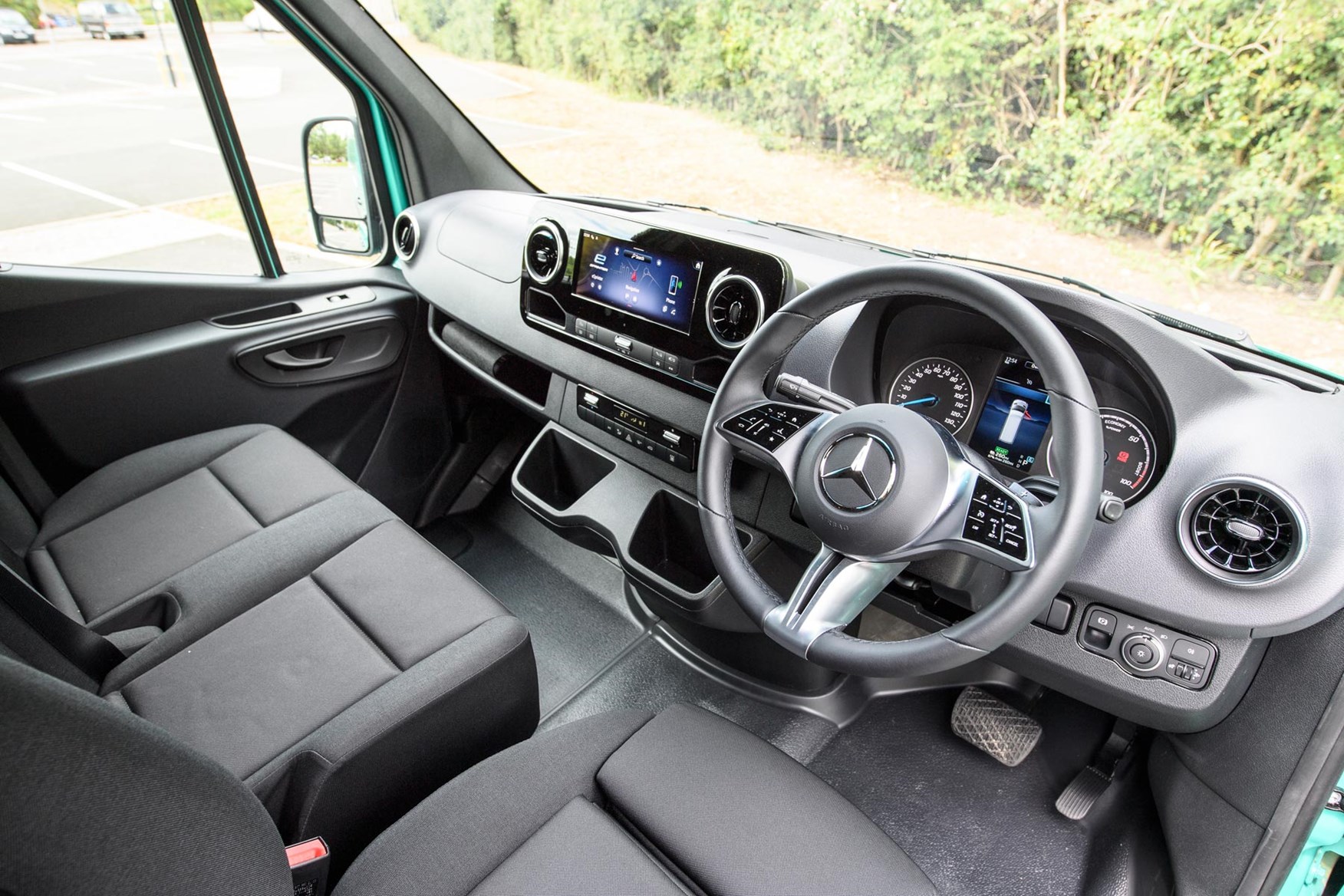
Should you wish it, you can specify extra and larger cupholders, although these are really more aimed at the sort of drinks sold in the US, where the large-battery eSprinter is expected to sell well. It doesn’t mean they are not worth having, as they are big enough to act as small storage pots, and they are more accessible than the other cup holders, which are high up on the dash.
- Two trims, lots of kit included
- Low running costs if you can control charging
- High purchase price
As with most electric vehicles, choosing to purchase an eSprinter will come down to whether you’re able to make it pay for itself. With a starting price of more than £73,000 this is truer as of the 2024 facelift than ever before, as this is more than 50% higher than the original starting price.
However, this doesn’t tell the whole story by a long way. First there is that vastly improved battery and range, which means you won’t have to charge as often and the eSprinter is more likely to fit into a wider range of use cases.
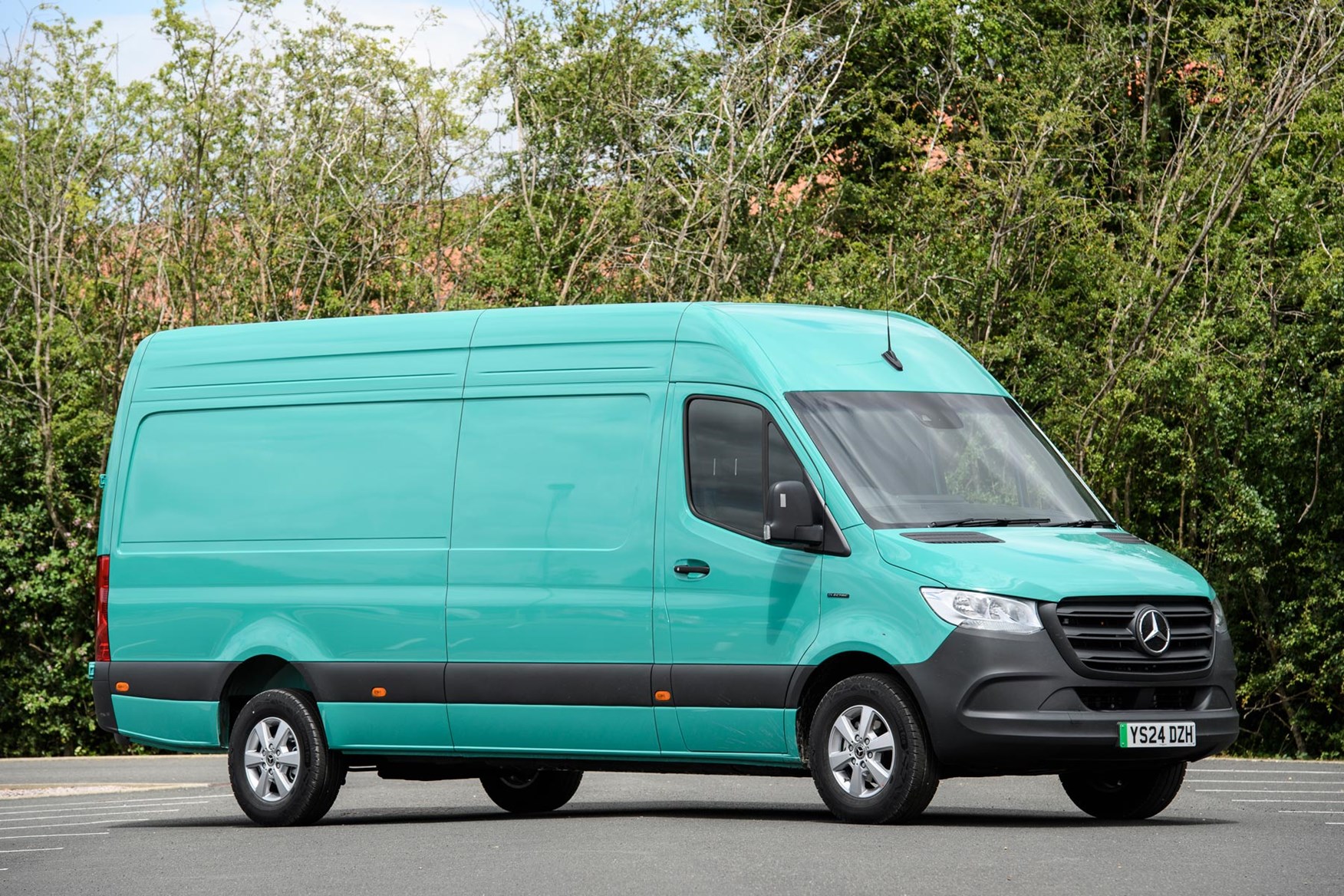
Secondly Mercedes has made a concerted effort to boost value, by now offering two trim levels and stacking it with more kit than before.
Mercedes eSprinter range and efficiency
The range is the new eSprinter’s feather in its cap as, at the time of its launch, it promises more miles from 100% to zero than any other large van. The 414 version is theoretically capable of 271 miles, although this reduces slightly to 263 miles for the 420 model. Thankfully, going for the higher trim doesn’t have an impact on the official range.
These improvements come about as a result of various changes that Mercedes has made to the eSprinter, and aren’t all down to the bigger battery. There are tweaks to the aerodynamics and improved tyre performance. Worth bearing in mind if you are looking to save a few pennies when replacing the rubber – it might cost you in other ways.
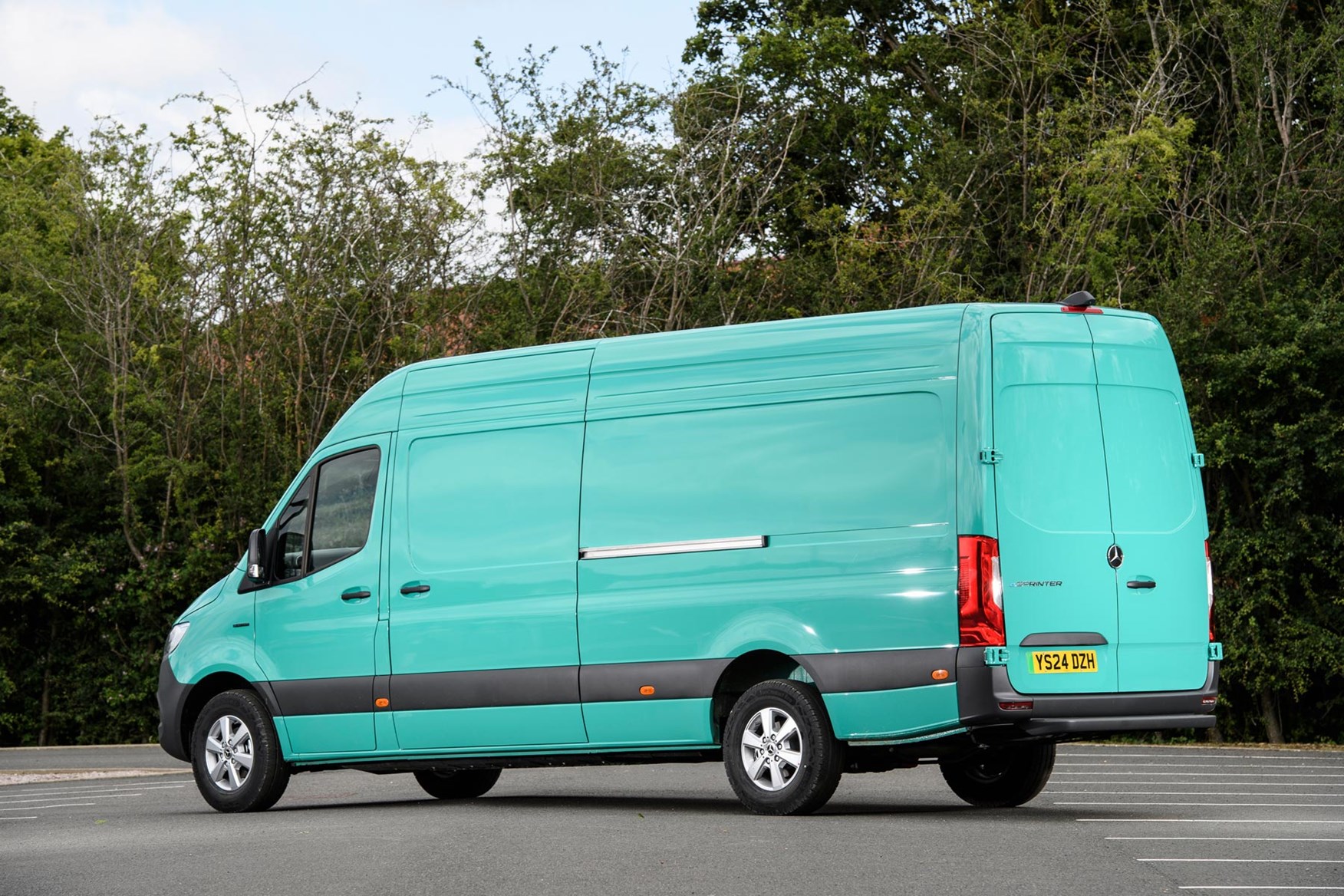
By taking care and driving parsimoniously it should be possible to eke that much and more out – we managed 3.1miles per kW over an hour-long relatively hilly test route with a small payload on board. The latter is the crucial factor, though, and we haven’t tried it out with anything close to a full payload.
The ability to charge at 115kW is a real boost, too, but the sort of public chargers that offer this sort of speed tend to be expensive to use, to leaving it plugged in overnight back at base might well be the better option on a regular basis.
Mercedes-Benz eSprinter warranty
Like all Mercedes vans, the eSprinter is warranted for three years and unlimited mileage – a boon to those who intend to use it to its maximum capacity most days. Furthermore, the battery pack is warranted for eight years/100,000 miles.
Mercedes-Benz eSprinter service intervals
The Mercedes eSprinter service intervals are set at 12 months or 40,000 miles.
Mercedes-Benz eSprinter standard equipment
The eSprinter is now available with a choice of two trims, which marks a distinct improvement over the first version of the electric van. These are called Pro and Select, and both come with a strong level of equipment.
Mercedes-Benz eSprinter Pro standard equipment highlights:
- Multifunction steering wheel with height and reach adjustment
- Instrument cluster with colour display
- Heated driver’s seat with armrest
- Double passenger seat
- Pre-entry climate control
- Air conditioning
- Electrical parking brake
- Full height bulkhead
- Double side-opening rear doors, with 270-degree opening
- Loading bay lining
- MBUX multimedia system with 10.25-inch touchscreen
- DAB digital radio, Bluetooth
- Apple Carplay and Android Auto
Mercedes-Benz eSprinter Select standard equipment highlights (in addition to Pro):
- Front and rear mud flaps
- Leather steering wheel
- Comfort driver’s seat with lumbar support and convenience head restraint
- Cup holders in front
- Hinged lid for stowage compartment
- Highbeam Assist
- LED High Performance headlamps
There’s little to say on this front. The diesel Mercedes Sprinter is the most reliable van on sale, according to the latest FN50 van reliability survey and it has remained so for several years in a row. With fewer moving parts to go wrong, the eSprinter should be, if anything, more reliable still.
The diesel Sprinter has had three official recalls, though the last one involved just four vans and being related to transmission fluid wouldn’t have affected the eSprinter anyway. Mercedes also offers its MobiloVan roadside assistance, free for any Mercedes van up to 30 years old as long as it’s last been serviced at a Mercedes-Benz dealer.
- Lots of safety equipment
- Standard alarm and built-in connectivity
- Assistance systems rated fairly well by Euro NCAP
The Mercedes eSprinter packs in a lot of standard safety equipment that you’d have to pay for on other vans, particularly its autonomous emergency braking, active lane-keeping assist, crosswind assist and driver attention alert.
It is only rated as Silver in the Euro NCAP assessment, although this was on a diesel van rather than the electric model.
Mercedes-Benz eSprinter safety equipment
- Active Brake Assist
- Hill-Start Assist
- Blind Spot Assist
- Crosswind Assist
- Active Lane Keeping Assist
- Attention assist
- Sideguard Assist
- Intelligent Speed Assistant
- Cruise control
- Tyre pressure monitoring front and rear
- Breakdown management
- Reversing camera
- Rain sensor
Which Mercedes-Benz Sprinter eSprinter is best for me?
There is more choice here than ever before, with two trims and two motors on offer. Given the high level of kit in the Pro model, that is the one that makes more logical sense. Equally, there is little discernible difference between the two motors, so the lower powered version shouldn’t feel like a compromised option.
However, the elephant in the room is the 4.25-tonne gross vehicle weight of the 113kWh battery. Unless you really need the long range, then we would be keen to wait and see what the 81kWh version has to offer in terms of range versus payload.





































